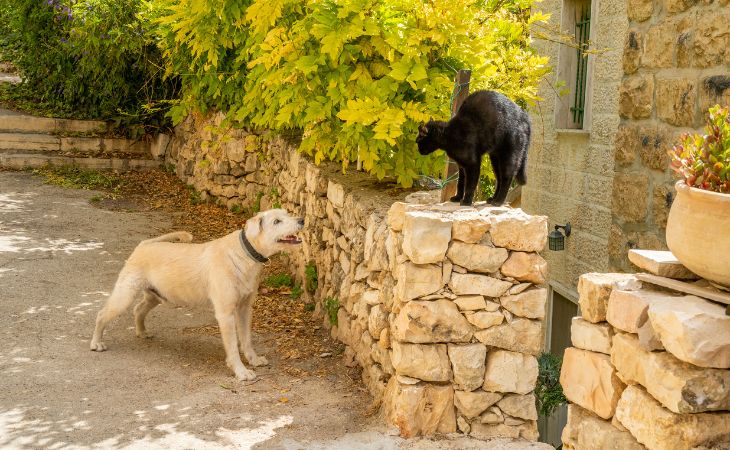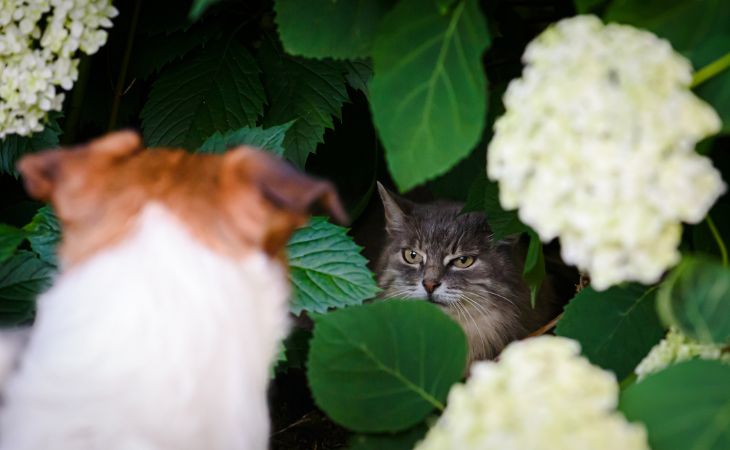Even though your cat has become aggressive towards your dog, harmonious cohabitation is still possible. It’s important to understand the causes of aggressiveness in cats towards dogs and put into place a progressive plan of action to resolve the situation. With patience and effort, you can create a peaceful and safe environment for your pets. Letsgetpet will give you some tips to help your cat and dog get along.
What are the possible causes of aggressiveness in cats towards dogs?
Several reasons can explain the aggressive behavior of cats. It can be from stress, a lack of socialization, or other things.
Environmental changes and stress
Cats are animals that are sensitive to changes in their environment. It could be from moving house, a house renovation, or any other disruption. These events can make your cat feel unsafe. These changes in the environment can be a major source of stress for cats.
A stressed cat can become more irritable, anxious, and react excessively to situations that wouldn’t have normally bothered them. This state can trigger aggressive behavior towards other animals, even dogs.
Territoriality and predator instincts of cats
Contrary to dogs can that can be more willing to socialize, cats are territorial animals par excellence. They establish zones that belong to them and seek to protect the zones against all intrusion. When a dog is introduced to an environment of a cat, they can be perceived as an intruder of the territory. This perception triggers the predator instincts of cats and can be accentuated by their hunting nature. Dogs can be perceived as a threat that bothers the balance and safety of the territory of cats.
When a cat attacks a dog, they can try to get further by using typical behavior of hunting (agitation of the tail, furtive approach and claw scratches). The cat can also groan or hiss to warn the dog to keep their distance. Their behavior reflects the territorial instincts of cats that seek to establish or reaffirm their dominance in their spoace.
Traumatizing experiences
Traumatizing experiences from the past can have a deep impact on the behavior of cats towards dogs in general. Cats remember negative experiences, even from a long time ago. If a cat has confronted an aggressive, intimidating or violent dog, they can develop a general mistrust of dogs.
They will then associate their negative interactions with the presence of all dogs. These experiences from the past can push them to adopt aggressive behavior towards dogs even if they are not directly threatened. This could be the case of your cat.
The lack of socialization
A cat that has not been correctly socialized with dogs can perceive them as threatening strangers rather than as potential companions. The lack of positive exposition to dogs can lead to a deep mistrust of them, because the cat has not learned to recognize their signs, behavior, and intentions.
Cats that are socially well-adapted have a tendency to adopt more calm and curious behavior towards dogs because they have learned to interact in an appropriate manner with them since they were very young. However, a non-socialized cat can be defensive, ready to attack to protect themself against what they perceive as a threatening stranger.
The state of their health
The aggressiveness of a cat towards a dog can be related to urinary diseases, muscular or bone problems, endocrine, neurological or viral disorders, etc. Cats can sometimes react aggressively due to their pain or an underlying illness.
If the cat suddenly manifests aggressiveness towards your dog, this can be due to the state of their health. It is then necessary to consult a vet to evaluate their physical health.
You might enjoy reading this article: How to understand your cat’s body language

How do I deal with my cat being aggressive towards my dog?
Now that the possible reasons behind why your cat is being aggressive towards your dog have been identified, you need to know how to handle this delicate situation. For this, you need a methodical plan of action to help your companions coexist together harmoniously.
Separate the two pets and create specific zones for each of them
In a situation of conflict, your first reflex needs to be separating the animals to prevent new aggressions. This separation gives the cat the opportunity to calm down and reduce their stress levels. If the dog is a source of nervousness for the cat, this initial distance will help reduce this reaction. If possible, put in place physical barriers or doors so that they can see, but not make direct contact with each. This will allow the cat and the dog to observe each other without the risks of aggression.
You need to absolutely avoid disrupting the cat’s routine, especially if they arrived before the dog. The goal is to minimize the most amount of stress possible related to the division of territories. If the cat arrived after the dog, they will adapt more easily to the existing space.
When you have a cat that shares a territory with another animal, you need to create defined zones for specific activities. Ensure that there are distinct areas to relax, play, groom themselves, and eat. This separation should avoid aggressive behavior from developing.
Use pheromones and proceed with a gradual approach
The use of pheromones can be a big help. These calming substances contribute to creating a more calm and familiar environment. The goal is to gradually introduce the odors of each animal in the respective spaces. This will allow the two animals to get used to each other’s smell gradually over time.
Once the cat seems to be more at ease around the dog beyond the barrier, you can start to let them try to approach each other. Bring them together in a neutral area for short periods, but be ready to intervene at the slightest sign of aggression. The goal is to associate this proximity with positive experiences.
If your cat does not show signs of irritation or aggression, reward them immediately with treats, caresses, or toys. During these encounters, to avoid all aggressive confrontation, someone can distract the dog if they insist on interacting with the cat in an excessive way.
Identify the signs of stress
During interactions with the cat and the dog, keep an attentive eye on the signs of stress of the cat. For example, ears laying flat down on the head, their hair standing upright, and groans can indicate your cat’s discomfort. You can note the specific elements that trigger these reactions. It can be excessive barking of the dog or sudden movements. This identification can allow to adapt to meetings consequently to minimize the stress of the cat.
Ensure healthy cohabitation and educate your dog
If all is going well, your cat should gently reduce their sensitivity and their aggressiveness in the presence of the dog. Gradually lengthen the time your furry friends spend together. Always pay close attention to their interactions to detect anything that may be disturbing your cat.
When the cohabitation seems to improve, make sure your dog respects the cat’s boundaries. Use recall commands to maintain control over you dog and prevent intrusive interactions. Also provide your cat with secure areas where they can retreat if necessary.
The solution for aggressive cats with dogs: the intervention of a professional
If despite your efforts, the situation does not improve and the aggressions of your cat towards you dog persists or gets worse, it is time to search for professional assistance. The hostile behavior of a cat can put in danger the safety of your dog and put in place an environment of stress.
You can solicit the help of a vet or a feline ethologist. A vet consultation is necessary to rule out any medical condition that might explain the cat’s aggressiveness. A feline ethologist can tell you more about the cat’s complex behavior. They will also help you draw up a better cohabitation plan, taking into account the needs and environment of both your cat and dog.
You might find this article useful: Why does my dog ignore my cat?

